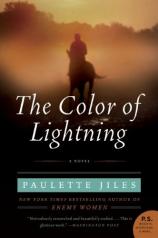The Color of Lightning
Review
The Color of Lightning
We’ve come a long way from simplistic racist fables about how the West was “won” (some would say stolen). Native American culture was all but obliterated in the process; the settlers, though courageous, were as much destroyers as heroes. A Hollywoodized but potent landmark in this historical revisionism was the famous 1956 movie The Searchers, directed by John Ford and starring John Wayne. It is the story of a quest to recover a white girl captured by the Cochise --- who turns out not to want to be rescued.
That is also the theme of a stunning new book, THE COLOR OF LIGHTNING. But Paulette Jiles --- whose earlier historical novel, ENEMY WOMEN, upended conventional wisdom about the righteous Union Army and the villainous Confederates --- takes the stereotype-smashing even further. Her hero, based on a little-known historical figure, is a freed slave, Britt Johnson, who leaves Kentucky with his family as the war is ending (1863) and strikes out for Texas. It was “a good place to be a black man. …[A] person could pretty much do what he liked and he could be whatever he took a mind to as long as he had a strong back and a good aim.”
Jiles makes us see that going to this region is like going to the moon --- the geography uncertain, the dangers amorphous. Maps of the time “faded into vast unmarked spaces” west of the Missouri River. Everything is hearsay and guesswork, including information about the native peoples with whom the settlers unpeacefully coexist. The same year the Johnsons arrive, 700 Comanche and Kiowa descend on the community while Britt and the other menfolk are away. The raid, cinematically described, is brutal: slaughter, scalping, rape and capture. Among those taken are a neighbor, Elizabeth Fitzgerald, and two of her grandchildren, who go with the Comanche; and Britt’s wife Mary, his daughter Cherry, and his son Jube, who are with the Kiowa (prisoners are split up to make escape and rescue more difficult).
The women’s attempt to survive their imprisonment in an alien culture (which is meticulously and vividly detailed) is both grim and fascinating. Mary, first described as “unstinting” in her talk, laughter and singing, is reduced to sign language. Elizabeth, gaunt and desperate, is fueled by anger and her determination to keep the children alive. Jiles, who also told of an epic journey against tremendous odds in ENEMY WOMEN, seems to have a gift for creating heroines who are both pragmatic and visionary.
Britt, meanwhile, sets out to find and buy back the captives. Endowed with the qualities of an iconic Old West hero (though more Clint Eastwood than John Wayne) --- fearlessness, sensitivity, pride, tolerance, a firm sense of right and wrong --- he even manages to transcend racial barriers, while sometimes being victimized by them. Venturing into still more alien country in pursuit of the nomadic tribes (Jiles makes the landscape come alive as we discover the flora and fauna through this stranger’s eyes), he encounters Tissoyo, a Comanche who speaks Spanish, a language Britt understands. They form an alliance of sorts. In exchange for saving Tissoyo’s life during a fierce prairie fire, Britt receives his help in negotiating for Mary, Elizabeth and the children.
A fourth narrative concerns Samuel Hammond, a Quaker from Philadelphia who is designated as Indian agent for the territory and comes off as a sort of holy fool. Well-intentioned and idealistic, he believes that the “civilizing” influence of kindness and faith (with some plows, food and calico thrown in) will rid the area of endemic violence. The project, of course, is doomed; the Native Americans have absolutely no interest in becoming godly, domesticated members of the community. By the end of the book, Samuel sits “in the ruin of his own personal philosophies as if they were smoking timbers in a heap….”
Britt, unlike his Quaker foil --- the triumvirate of Britt, Tissoyo and Samuel is clearly meant to represent different poles of the frontier experience --- is a man of action; he doesn’t preach nonviolence (while building his freighting business, carrying goods in a wagon between outposts in the territory, he spots one of the natives who raped his wife and kills him without hesitation), but he isn’t macho, either. He shows a tenderness and patience in the face of Mary’s fragility after her return home. She has a sort of post-stroke dysphasia following a blow to the head when she was captured, and has to relearn language; she cannot bear for him to touch her, much less have sex.
But Elizabeth and Mary, although greatly altered, do not lose their identities during captivity. The rescued children, more malleable, are another matter: “He had brought back a family of changelings,” Britt says to himself. The kids are caught between two cultures; returned home, they do not want to sleep inside houses; they do not want to be schooled or sent to church. Cherry and Jube, who speak Kiowa privately, have contempt for “the devices of civilization. They seemed to have forgotten the years of childhood that preceded their life with the Kiowa as if it had only been a time of exile from their true lives in movement across the face of the great high-heated plains and its sky and its winds.”
Many of the children turn unruly or strange, as if in mourning; one boy starves himself to death. The story of the returnees is what gives the novel its tremendous resonance. Their fate encapsulates the profound gulf between settler society and Native American culture, yet doesn’t demonize either group nor sanctify it as morally superior.
In this sense the book is an anti-Western, with much of the genre’s vitality but none of its idiocy. It is excitingly plotted and paced; scenes of confrontation and suspense alternate briskly with moments of introspection and intimacy. It takes all that shoot-’em-up stuff and makes it almost Shakespearean. Jiles knows her territory (she lives in Texas) and her history, and she writes like a woman possessed. In THE COLOR OF LIGHTNING, she turns the legends and tragic realities of the West into something fresh and powerful.
Reviewed by Kathy Weissman on December 28, 2010
The Color of Lightning
- Publication Date: June 15, 2010
- Genres: Fiction, Historical Fiction
- Paperback: 384 pages
- Publisher: Harper Perennial
- ISBN-10: 0061690457
- ISBN-13: 9780061690457










